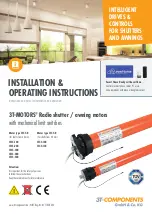
Chapter 6
PERIODIC INSPECTION AND MAINTENANCE PROCEDURES
6-3
Inspection of Damper
External inspection of damper
When installing a damper protective cover to the engine, do not use a cover that encloses the damper.
Installation of a closed cover can cause damper damage due to heat.
Check the vibration damper for oil leakage,
scratches, deformation, discoloration and peeling of
paint.
Check carefully for swelling on the cover (use a
scale), oil leaks from the shim, discoloration and
peeling of paint due to heat.
Note: If the vibration damper is defective, consult a
Mitsubishi dealer.
Damper temperature management
For proper operation, heat of the vibration damper must be dissipated from its surface to prevent excessive
damper heating. Mitsubishi inspects each engine before shipment to ensure proper operating temperature of
the vibration damper. However, the vibration damper temperature varies depending on ambient conditions.
Therefore, observe the following suggestions and provide sufficient ventilation for the vibration damper and
equipment.
In the case of viscous damper of regular use engine, make sure the temperature of the outside damper sur-
face does not exceed 90
°
C [194
°
F] after the engine is operated at the rated output for 1 hour, and emer-
gency engine for 100
°
C [212
°
F]. In the case of viscous rubber damper of regular use engine, make sure the
temperature does not exceed 80
°
C [176
°
F], and emergency engine for 90
°
C [194
°
F]. It is recommended to
use the thermo label for temperature management of the vibration damper in regular use engine.
When installing a safety cover over the vibration
damper, check ventilation carefully and make sure
the damper temperature remains below the above
temperature with the cover in place.
Table 6-1 Temperature Management with Thermo Label
Parts name
Parts No.
Temperature
measuring
range
Thermo label
75-95
32522-04100
75 to 95
°
C
[167 to 203
°
F]
Thermo label
100-120
32522-04200
100 to 120
°
C
[212 to 248
°
F]
Thermo label
50-70
32522-04300
50 to 70
°
C
[122 to 158
°
F]
fig.6-2 Inspecting the damper
Cover
fig.6-3 Managing the damper temperature
















































